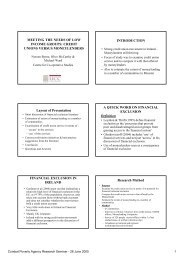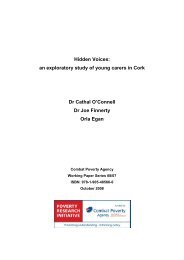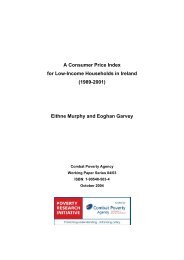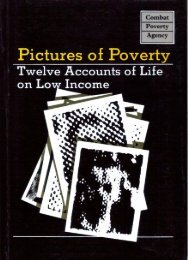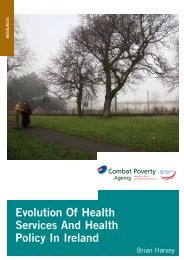The Distribution of Income in Ireland (2000) - Combat Poverty Agency
The Distribution of Income in Ireland (2000) - Combat Poverty Agency
The Distribution of Income in Ireland (2000) - Combat Poverty Agency
- No tags were found...
Create successful ePaper yourself
Turn your PDF publications into a flip-book with our unique Google optimized e-Paper software.
70<strong>The</strong> <strong>Distribution</strong> <strong>of</strong> <strong>Income</strong> <strong>in</strong> <strong>Ireland</strong>Table 6.1: <strong>Distribution</strong> <strong>of</strong> Earn<strong>in</strong>gs, <strong>Ireland</strong> 1987, 1994 and1997As Proportion <strong>of</strong> MedianAll employees, hourly earn<strong>in</strong>gs:Bottom decileBottom quartileTop quartileTop decileFull-time employees, weekly earn<strong>in</strong>gs:Bottom decileBottom quartileTop quartileTop decile19870.470.731.371.960.500.751.351.8219940.470.681.502.240.480.721.431.9719970.480.691.532.320.510.71This shows that from 1987 to 1994 there was a consistent widen<strong>in</strong>g<strong>in</strong> dispersion for both weekly and hourly earn<strong>in</strong>gs, particularlyat the top <strong>of</strong> the distribution. <strong>The</strong> ratio <strong>of</strong> the top decileto the median rises from 1.96 to 2.24 for hourly earn<strong>in</strong>gs, andfrom 1.82 to 1.97 for weekly earn<strong>in</strong>gs among full-time employees.For hourly earn<strong>in</strong>gs the bottom decile is the same proportion<strong>of</strong> the median <strong>in</strong> 1987 and <strong>in</strong> 1994, but for weekly earn<strong>in</strong>gsamong full-time employees the bottom decile falls from 0.50 to0.48 <strong>of</strong> the median. <strong>The</strong> ratio <strong>of</strong> the top to the bottom decile,commonly used as a s<strong>in</strong>gle summary <strong>in</strong>equality measure <strong>in</strong> thiscontext, rose from 4.2 to 4.8 for hourly earn<strong>in</strong>gs and for weeklyearn<strong>in</strong>gs <strong>of</strong> full-time employees the <strong>in</strong>crease was from 3.6 toBetween 1994 and 1997, the top decile cont<strong>in</strong>ued to movefurmer away from the median, reach<strong>in</strong>g 2.32 for hourly earndeSlIn t 0tt ° m ^ ° f the **•*•** however, the bottomma^rX, T T* "** ** median if' ***** <strong>in</strong>creas<strong>in</strong>gZSZZL T * a reSUlt the'rati <strong>of</strong> the° *°P to the bottomlv dol atTn r 9 ^ ^ 48 f r hOUlly°eami^s' and m ~9<strong>in</strong>-C^h I T WeeWy 6arnmgS amon 9 **-*«» worker!SU^ZTJ,^Peri ° d fr ° m 1987 t0 i997 '1.422.02then - there was awages among all employees. This was more pronounced <strong>in</strong> the<strong>The</strong> <strong>Distribution</strong> <strong>of</strong> Earn<strong>in</strong>gs 711987-94 period than from 1994 on, so rapid economic growthdid not lead to an acceleration <strong>in</strong> the trend. It was primarilydriven by relatively rapid <strong>in</strong>creases for those towards the top <strong>of</strong>the distribution, with no <strong>in</strong>dication - unlike for example the UKor the USA - that the bottom was fall<strong>in</strong>g beh<strong>in</strong>d the median.6.4 IRELAND'S EARNINGS DISTRIBUTION IN COMPARATIVEPERSPECTIVEA comparative perspective on the Irish earn<strong>in</strong>gs distribution,and on the way it has been chang<strong>in</strong>g, can be obta<strong>in</strong>ed us<strong>in</strong>gmeasures <strong>of</strong> earn<strong>in</strong>gs dispersion for a range <strong>of</strong> developedcountries brought together by the OECD (1996b). <strong>The</strong>re arepotentially important differences <strong>in</strong> def<strong>in</strong>ition and coverageacross countries (<strong>in</strong>clud<strong>in</strong>g whether earn<strong>in</strong>gs are weekly or annual),so these comparisons should be treated with extremecare, but they can serve to highlight some key features <strong>of</strong> theIrish results. S<strong>in</strong>ce they cover only up to the mid-1990s, we usethe Irish figures for 1994 and for trends between 1987-1994 forcomparative purposes.First, Table 6.2 shows measures <strong>of</strong> the level <strong>of</strong> earn<strong>in</strong>gs dispersion<strong>in</strong> 1994 for <strong>Ireland</strong> and other OECD countries, forweekly pay among full-time employees (s<strong>in</strong>ce the figuresbrought together by the OECD generally refer to full-time employees,and to weekly, monthly or annual rather than hourlygross earn<strong>in</strong>gs). <strong>Ireland</strong> is seen to have a particularly high level<strong>of</strong> earn<strong>in</strong>gs dispersion. Both the ratio <strong>of</strong> the top decile to themedian and <strong>of</strong> the median to the bottom decile are among thehighest <strong>of</strong> the countries covered. With the top decile/bottomdecile summary measure, only Canada and the USA are seen tohave greater earn<strong>in</strong>gs <strong>in</strong>equality than <strong>Ireland</strong>.As far as trends <strong>in</strong> earn<strong>in</strong>gs dispersion are concerned, Table6.3 shows the ratio <strong>of</strong> the top to the bottom decile <strong>in</strong> 1987 and1994 f °r <strong>Ireland</strong> and the other OECD countries for which thefigures are available for both po<strong>in</strong>ts <strong>in</strong> time. We see that oncea ga<strong>in</strong> <strong>Ireland</strong> is an outlier: the <strong>in</strong>crease <strong>in</strong> earn<strong>in</strong>gs dispersionls the greatest <strong>of</strong> any <strong>of</strong> the countries shown. (<strong>The</strong> US is not <strong>in</strong>cluded<strong>in</strong> this table because OECD 1996 gives only US figures0rmen and women separately, but from these it appears that




